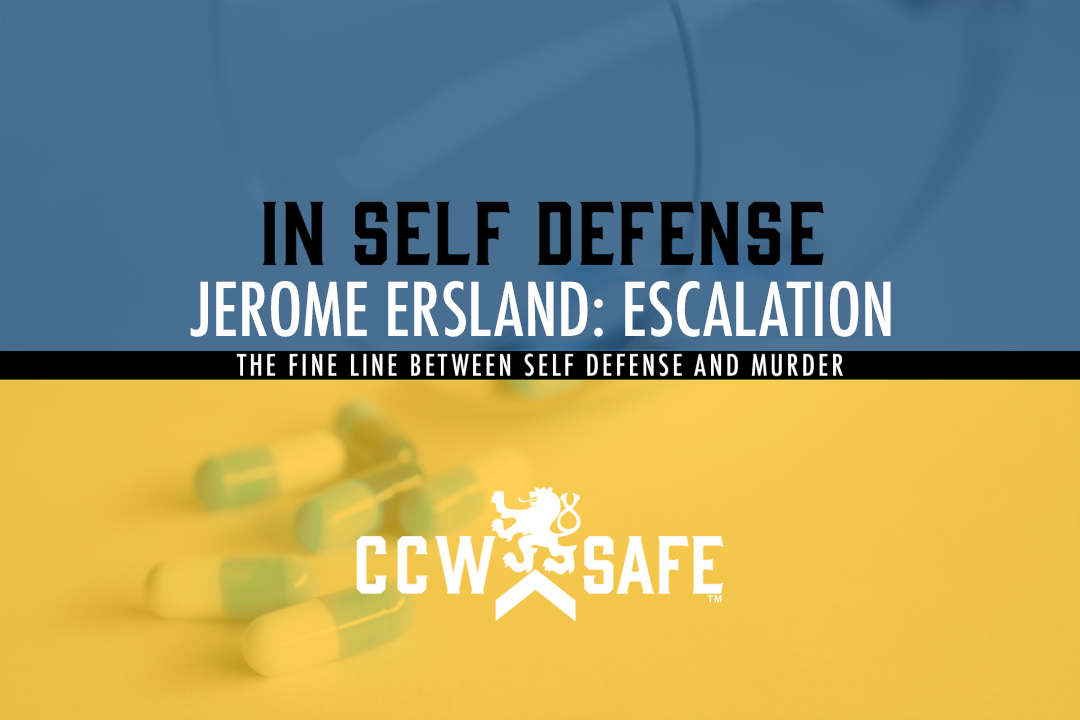
Posted on March 1, 2019
“In Self Defense” The Jerome Ersland Case: The Line Between Self Defense And Murder- Escalation
The Jerome Ersland Case
The line between self-defense and murder
Part 3: Escalation
In our series “The Four Elements of Self-Defense,” we explore how location, escalation, reasonable fear, and post-incident actions can affect the legal defense in self-defense shooting. In the next installment, we’ll look specifically at how the concept of “escalation” factored into Ersland’s legal defense.
Teenagers Antwun Parker and Jevontai Ingram entered Reliable Discount Pharmacy in Oklahoma City for one reason: armed robbery. Both covered their faces with ski masks. Ingram produced a pistol.
Jerome Ersland, the pharmacist on duty, had been the victim of an armed robbery before. He knew criminals were drawn to pharmacies because of the narcotics they stocked. Ersland retrieved a Taurus Judge, loaded with both .410 buckshot and .45 rounds, and fired. A pellet struck Parker in the head and he fell to the ground. Ingram fled. Ersland pursued Ingram out the door, firing two or three rounds down the street at the fleeing assailant.
Then Ersland re-entered the pharmacy, stepped over Parker’s body, retrieved a Kel-Tec .380 from a drawer behind the counter, charged the weapon, and fired five more rounds into Parker’s still, incapacitated body.
Oklahoma City District Attorney David Prater admitted the first shot Ersland fired was justified, but he told a jury the final five shots were “nothing less than an execution.”
In many of the self-defense cases we have analyzed in The Four Elements of Self-defense, the shooter took some action that escalated the conflict, making the deadly encounter more likely. In the tragic Ted Wafer case, Wafer opened the door to an unknown person who was violently banging and trying to gain entry in the early morning hours of a cold autumn night. In the Michael Dunn case, Dunn got into a shouting match with teenagers in a parking lot over loud music. In the Ronald Gasser case, Gasser had engaged in what investigators called a “tit-for-tat” road rage incident that went on for miles.
It’s hard to say that Jerome Ersland did anything to provoke the armed robbery. He fired only when Ingram presented a gun.
Had the engagement ended there, had Ersland called the police instead of pursuing Ingram out of the pharmacy, had he called for aid for Parker instead of shooting him five more times — then Ersland would likely never have been prosecuted for first-degree murder.
However, when Ersland followed Ingram outside and fired at the retreating assailant, he crossed a line and stepped up the nature of the conflict. CCW Safe’s Critical Response Coordinator Gary Eastridge worked with the Oklahoma City DA during the Ersland case. Before that he was a homicide detective for Oklahoma City, and frequently investigated officer involved shootings.
“A police officer may have other obligations to chase a suspect,” Eastridge says, “but a civilian does not.” He explains that a police officer would have had to decide if allowing the suspect to flee would have put other people in danger before firing at a fleeing felon. Civilians are not supposed to wrestle with that decision. The law is clear: you can’t use deadly force against someone who is running away from you.
Although Ersland’s shots at Ingram are difficult to justify, because no one was injured, Eastridge doubts that Ersland would have been prosecuted for those shots, considering he had just been the target of an armed robbery. However, when seen in context of the shooting of Parker moments later, Eastridge says, “That decision making process and his actions became aggravators to show his actions were not justifiable.”
If Ersland inappropriately took on the role of police officer by giving chase and firing at the retreating robber, then he also took on the role of prosecutor when he made the decision to perform the “execution” of Parker, to borrow the word used the District Attorney David Prater. It’s clear from the evidence Parker was no longer a threat; Ersland was exacting a punishment.
The lesson for the concealed carrier is that private citizens don’t have the same rights as law enforcement officers when it comes to the use of firearms. If you are the victim of a violent crime, you may feel justified in taking the law into your own hands, but you are not. You can only use deadly force to eliminate the threat of immediate death or bodily harm. Once the imminent threat is neutralized, the justification for deadly force is gone.
In our series “The Four Elements of Self-Defense,” we explore how location, escalation, reasonable fear, and post-incident actions can affect the legal defense in self-defense shooting. In the next installment, we’ll look specifically at how the concept of “reasonable fear” factored into Ersland’s legal defense.
 |
SHAWN VINCENT- LITIGATION CONSULTANTShawn Vincent is a litigation consultant who helps select juries in self-defense cases, and he manages public interest of high-profile legal matters. If you have any questions for Shawn, or would like more articles like this, let us know belo |